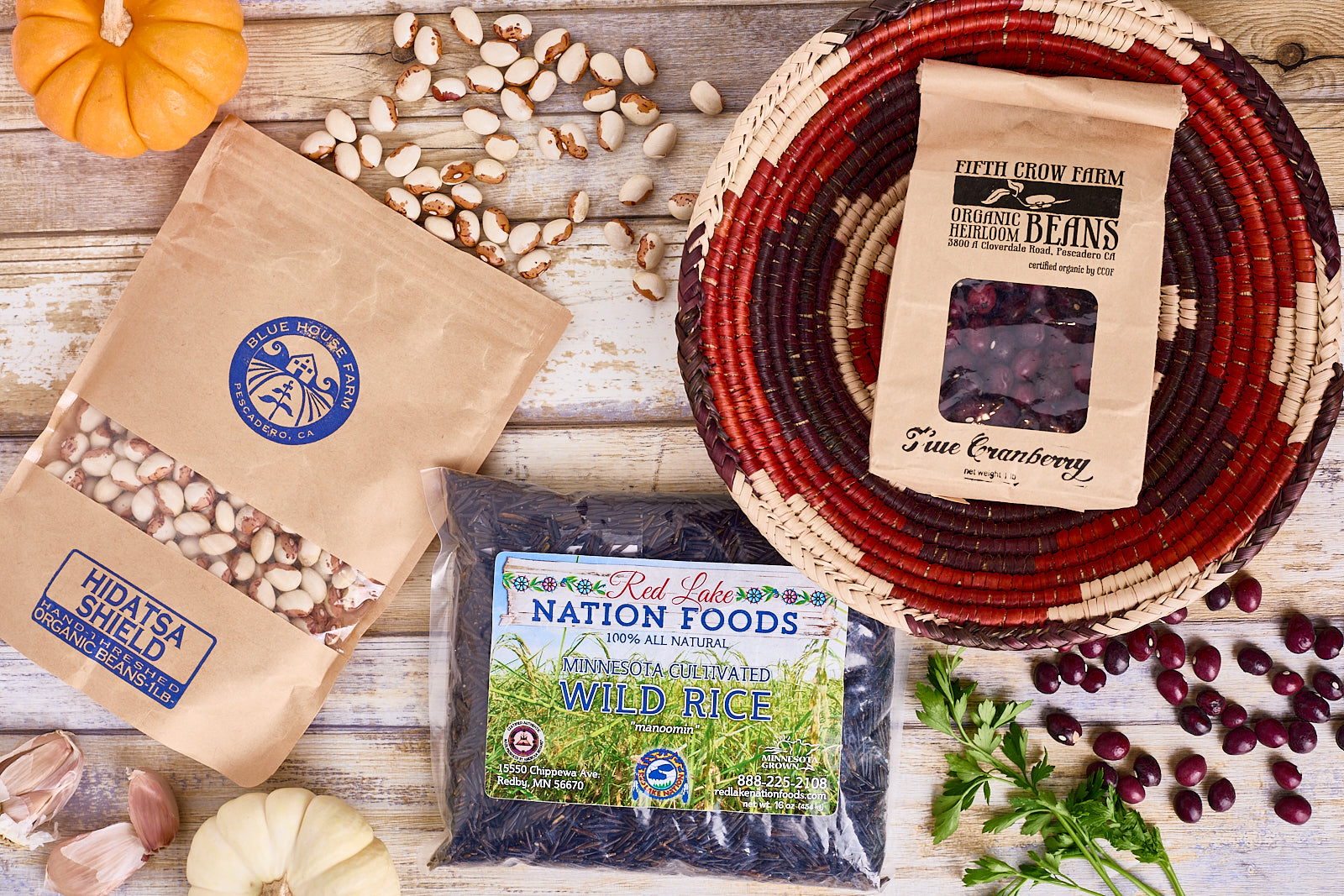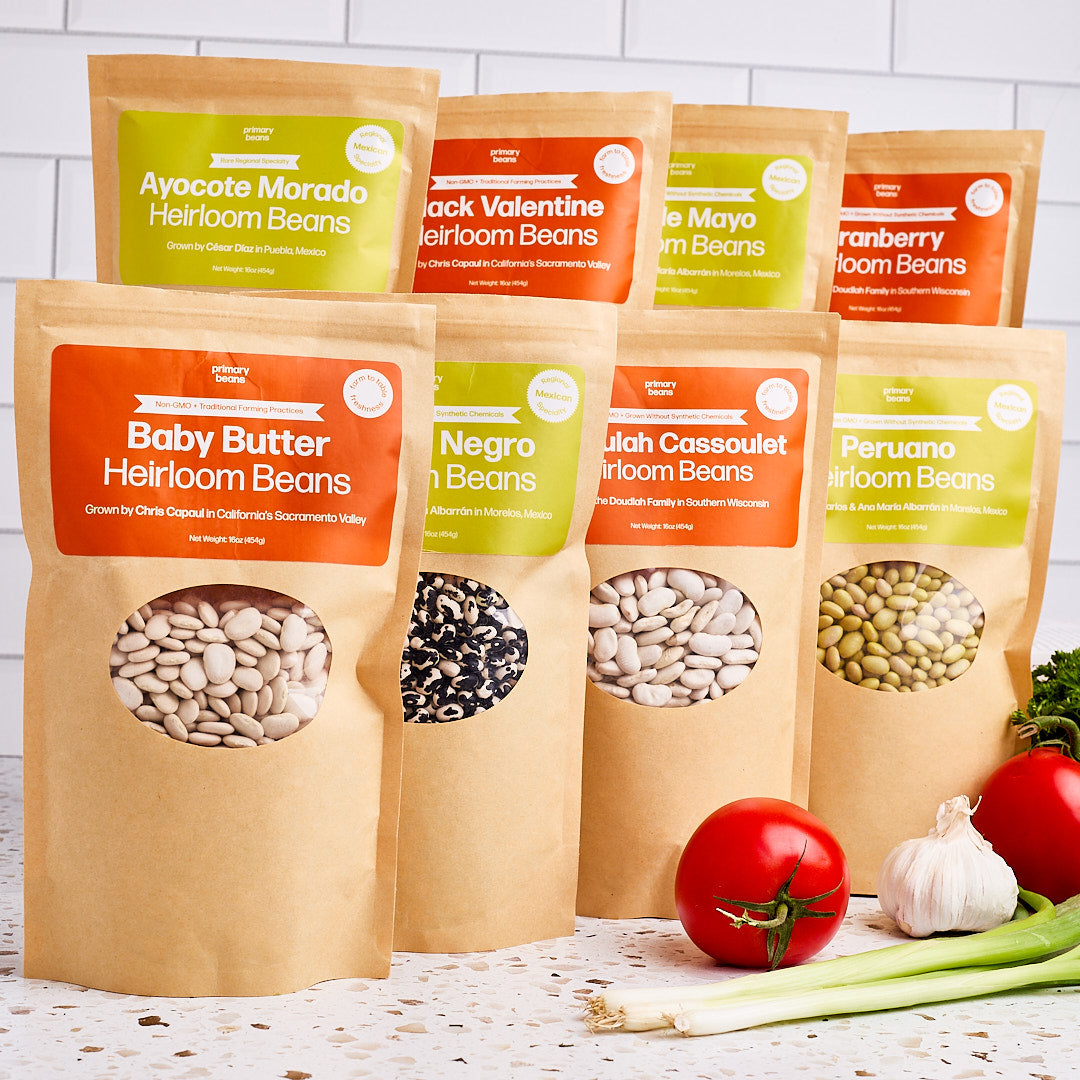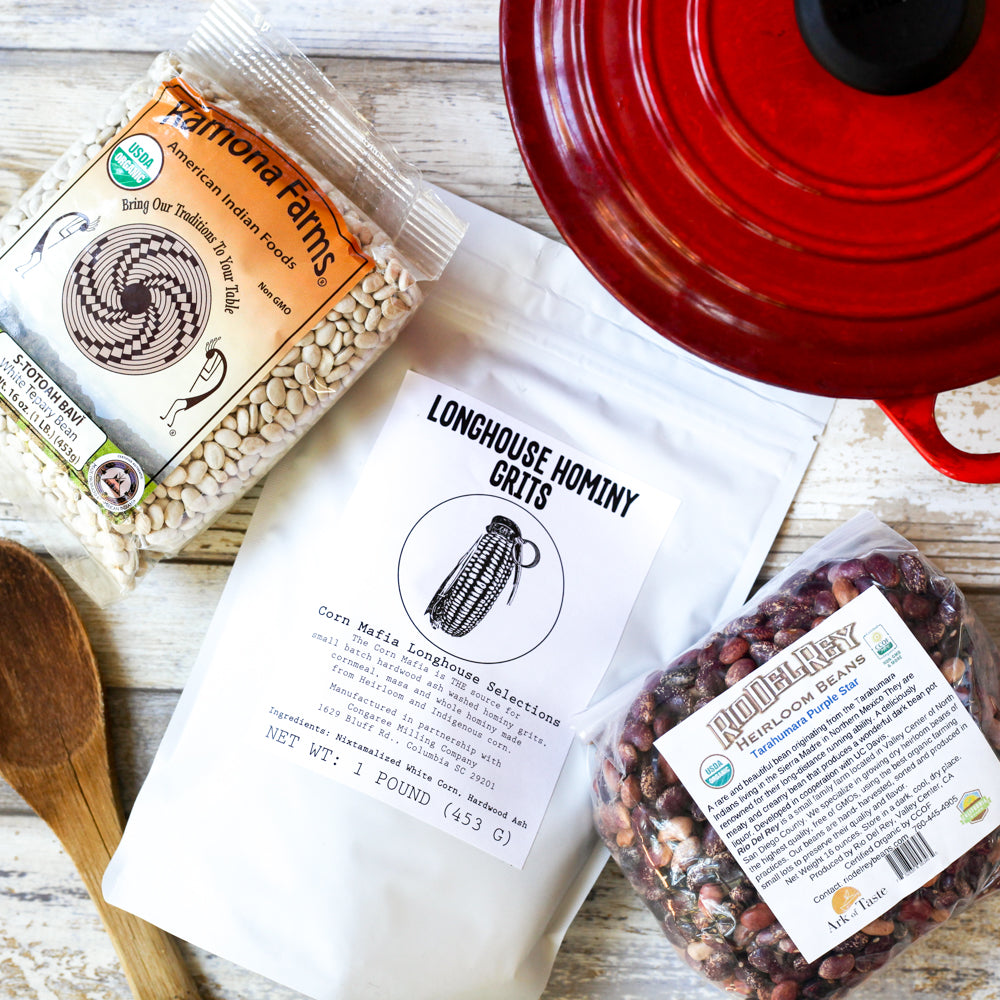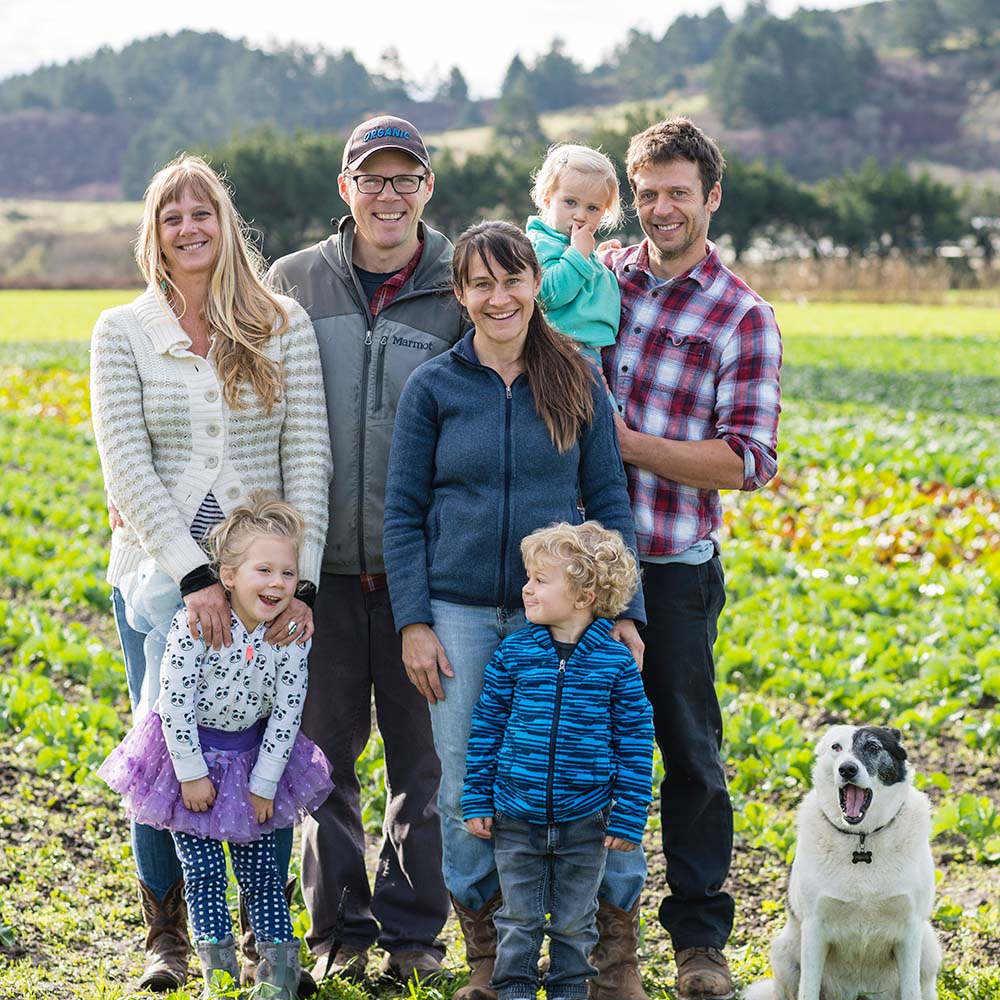10.99 FLAT RATE SHIPPING
10.99 FLAT RATE SHIPPING
SHOP

October 2024 Heirloom Bean and Grain Club
September 24, 2024 8 min read
This October, we’re honoring Indigenous People’s Day with a special selection of ingredients that celebrate the rich food traditions of Native cultures. This month’s Bean and Grain Club features three standout ingredients, all grown with care on small family farms and Native lands. First, we have the Hidatsa Shield Figure Beans, an heirloom variety with deep roots in the agricultural history of the Hidatsa tribe. Next, the True Red Cranberry Beans bring a vibrant pop of color and flavor to your table. Finally, we are thrilled to offer Native American grown and harvested Wild Rice from the Red Lakes Nation in Minnesota, a sacred and nourishing staple of the Ojibwe people. Each ingredient tells a story of heritage, sustainability, and tradition—perfect for cooking with meaning this October.
THE BEAN AND GRAIN BOX CONTAINS:
Organic Hidatsa Shield Figure Beans, Organic True Red Cranberry Beans, Native American Grown Wild Rice
THE BEAN ONLY CONTAINS:
Organic Hidatsa Shield Figure Beans, Organic True Red Cranberry Beans, Organic Bayo Beans
OUR NEW AND IMPROVED CUSTOMER PORTAL
Now you can easily claim rewards, add to your next shipment and so much more! We made a video walking you through exactly how easy it is to add some goodies to your order and get cash back. WATCH THE VIDEO.
NEW TO THE CLUB? Check out our blogposts with everything you need to know to get the most out of your membership in the heirloom bean and grain club.
How To Cook A Perfect Pot of Beans
The Definitive Guide To Cooking Beans
ORGANIC HIDATSA SHIELD FIGURE BEANS

The Organic Heirloom Hidatsa Shield Figure Beans from Blue House Farm are a wonderfully creamy and delicious heirloom bean with thin skins that retain their coloring after cooking for stunning soups and so much more. They are a nod to ancient agricultural traditions, named for the Hidatsa people of the Missouri River Valley in North Dakota. These large, white beans with speckled orange and maroon saddles resemble a shield, giving them their unique name. As one of five dry bean varieties cultivated by the Hidatsa, the Shield Figure bean is a unique find, earning a place on the Slow Food Ark of Taste in 2005. Although popular in home gardens because it's so darn prolific, it is not grown on large farms due to the difficulty of harvesting the vigorous pole bean on a commercial scale.
WHAT TO DO WITH THEM
With a firm, meaty texture and mild, slightly nutty flavor, Hidatsa Shield Figure beans are versatile and delicious in a variety of dishes. The delicious bean broth and creamy texture make them perfect for soups like the Hidatsa Shield Bean and Wild Rice Soup recipe that we created just for the bean club. I wanted to create a recipe that was as decolonized as possible, using almost entirely ingredients that are native to North America. Infused with a touch of cedar leaves, this comforting soup offers a woodsy, nourishing experience that honors Indigenous culinary traditions.
ABOUT THE HIDATSA TRIBE
The Hidatsa tribe, originally from the Missouri River Valley in present-day North Dakota, have a rich history as skilled agriculturalists and traders. Alongside the Mandan and Arikara tribes, they formed the Three Affiliated Tribes. The Hidatsa were known for their cultivation of corn, beans, squash, and sunflowers, using a sophisticated farming system that sustained their communities for centuries. They lived in semi-permanent earth lodges and were integral to the trading networks along the upper Missouri River. In the 19th century, like many Native American tribes, the Hidatsa faced devastating impacts from disease, displacement, and forced relocations. Today, many Hidatsa people reside on the Fort Berthold Reservation in North Dakota, where they continue to preserve their cultural traditions and agricultural heritage while adapting to modern challenges. The Hidatsa, Mandan, and Arikara maintain a vibrant community, working to revitalize their language, culture, and land stewardship practices.
ABOUT BLUE HOUSE FARM
Blue House Farm grows drop dead gorgeous beans from the gorgeous, fertile land in Pescadero and San Gregorio, California. Ryan Casey became interested in farming in college while taking agriculture courses. After completing an apprenticeship at the Center for Agroecology and Sustainable Food Systems and working on several farms, he decided to start an organic farm. The farm started in 2005 on 2 acres and has steadily grown to over 75 acres in production. Farming in two different microclimates allows Blue House Farm to grow over 50 types of certified organic farm products. Among the lettuce, tomatoes, herbs and peppers Blue House Farm grows excellent organic beans.
TRUE RED CRANBERRY
This stunning blood red bean is recognized in the Slow Food Ark of Taste and indeed resembles its namesake. One of America's oldest and most unique varieties, The Red Cranberry bean was rediscovered by bean collector John Withee after an 11-year quest in Steep Falls Maine. This rare heirloom had been used by Abnaki Indians centuries ago but became extinct shortly thereafter due its tall stature that made it difficult for harvesting when grown at lowlands or gradual slopes. This plumps up to be marble sized jewels with a dense yet creamy texture and a rich, earthy flavor.
WHAT TO DO WITH IT
We think there could be no better bean to use in Sean Sherman's Cedar Braised Beans than the True Red Cranberry. No cedar branches at your local market? No problem try a sprinkle of the cedar smoked salt from Sekari Farms and a drizzle of olive oil from Seka Hills support two tribal owned businesses! These flavorful little gems are also amazing in our 3 Sisters Tamales!

ABOUT THE FARMER
Fifth Crow Farms is an organic family owned farm in Pescadero, California. Grounded in a values-based approach to land stewardship, Fifth Crow Farm is a dynamic and diversified organic farm in Pescadero, CA. Founded in 2008 with a shoestring budget, a supportive local community, and ambitious dreams, they strive to bring eaters the highest quality, best tasting, and most nutritious food possible.
Fifth Crow Farm wants their farm to be more than a business: they strive to make it an engine for positive change in the food system. They are stewarding the land in a way that not only respects but improves habitat for wildlife and builds better soil for future farmers. They also believe in creating a healthy, fulfilling, and fair work environment, and providing their customers with the best tasting, most nutritious, highest quality food possible.

NATIVE AMERICAN GROWN AND HARVESTED WILD RICE
This isn't just any rice—it's a treasured indigenous staple grown and harvested by the Red Lake Nation. Wild rice, Manoomin in Ojibwe, isn't technically rice, it's the seed of a marsh grass often called a pseudograin. Manoomin means "good seed." It packs a punch with more protein, minerals, and B vitamins than regular rice. Plus, it's gluten-free and low in fat, making it a perfect addition to any healthy lifestyle.
Wild rice holds deep cultural significance for the Ojibwe (Chippewa) people, symbolizing sustenance, community, and tradition. September, known as the "ricing moon," marked a time when Ojibwe families would gather at lakeside camps to harvest this vital grain. The meticulous process of drying, parching, and separating the rice was a communal effort, culminating in a festival of thanksgiving in October where the first batch of the season was cooked and shared. Beyond its nutritional value, wild rice was also a key trade item, supporting the Ojibwe's economy and sustaining those who traveled by canoe to trade furs.
About Red Lakes Nation Foods
Red Lake Nation Foods is a Native American-owned company dedicated to producing specialty products that honor and represent the cultural heritage of the Red Lake Nation. Located in northern Minnesota, within the Red Lake Indian Reservation, the company serves over 10,000 members across four districts: Red Lake, Redby, Ponemah, and Little Rock. The reservation’s history dates back to the fur trade era, with significant Ojibwa settlement and the establishment of a British Northwest Co. trading post in 1806. Today, Red Lake Nation Foods continues to uphold the traditions and values of the Ojibwa people.

Wild Rice Pilaf With Caramelized Shallots and Crispy Sage
This warm and earthy wild rice dish pairs beautifully with mushrooms, caramelised shallots, and aromatic sage, offering a rich blend of textures and flavours. Finished with toasted pine nuts and crispy fried sage leaves, it’s a simple yet elegant recipe that works as a hearty side or a satisfying vegetarian main. GET THE RECIPE.
How To Cook Wild Rice
- Use a 1:3 ratio of wild rice to liquid. For example, combine 1 cup of raw wild rice with 3 cups of water or broth.
- Bring the liquid to a boil in a medium-sized pot.
- Stir in the wild rice, then cover the pot with a lid.
- Simmer for 45-60 minutes.
- The wild rice is done when the kernels are tender but not mushy, and many have burst open to reveal a cream-colored interior. *Be careful not to overcook, as this can cause the split kernels to curl.
Cooked wild rice will keep in the refrigerator for two weeks. Uncooked wild rice will last for years. As always, we recommend storing uncooked grains in the refrigerator to retain freshness.
ORGANIC BAYO BEANS ( BEAN ONLY BOX)
Step into the rich culinary world of central Mexico with Bayo Beans, a cherished heirloom variety that holds a special place in the heart of Mexican cuisine. These beans, often mistaken for their cousin, the Mayacoba, are in fact a distinct heirloom varieity. While Pinto beans reign in the north and black beans in the south, it's the Bayo bean that captures the essence of central Mexican cooking. Revered by locals for its creamy texture and rich flavor, Bayo beans are a staple on tables across the region. While the exact origins of Bayo beans remain shrouded in mystery, their prominence in the region is undeniable. Grown in Zacatecas, the birth place for many of the world's first bean varieties (perhaps even the Bayo), Armando Klein's small family farm is dedicated to organic practices, ensuring each batch maintains its authenticity and quality. These beans, with their earthy aroma and nutty undertones, are not only a testament to Zacatecas' agricultural heritage but also a celebration of its cultural identity.
WHAT TO DO WITH THEM
With Bayo beans, cooking becomes an effortless endeavor, as they require no soaking and cook in half the time of Pintos. Whether enjoyed simply in their broth or transformed into mouthwatering frijoles refritos, Bayo beans promise a culinary experience that's as comforting as it is delicious. So, join us on a journey to savor the flavors of central Mexico with Bayo Beans, where every bite is a celebration of tradition and taste.

FRIJOLES DE OLLA
This classic bean dish is amazing on it's own and it's the basis of Frijoles Refritos (refried beans). You can do this in the pressure cooker to speed up time if you but the tender bayo beans love a slow simmer and only take about an hour on the stove.
Ingredients:
1 pound of Bayo beans
1/2 Onion
4-5 Cloves of Garlic Peeled and Lightly Smashed
1-2 Yahualica Peppers (chili de arbol) - optional
1 Avocado or Bay Leaf
2 Tablespoons Salt
Rinse and drain the beans and place in a dutch oven with the rest of the ingredients. Add enough water to cover the beans by several inches and bring to a boil. Reduce the heat to a simmer and cover. Check them every 15 minutes, giving a gentle shake of the pot and adding water as needed to keep them covered and make a delicious soupy broth. Simmer on low for 50 minutes and check for doneness. The skins should be in tack but they should be creamy in texture. Remove the bay leaf, onion and pepper and serve. Serve them as is or with chopped red onion, cilantro, avocado and limes.
Recent Articles
About Us
Foodocracy is dedicated to creating a more sustainable and independent food system. We support small, independent farms across the nation.
Get impossible to find beans and grains shipped direct to your doorstep each month from small family farms.
We support small, family owned farms across the nation. Did you know that farmers only make an average of 10 cents on every dollar you spend at the supermarket? Working directly with farms and not middle men ensures that more money goes back to the people actually growning your food.
Get 10% Off
Sign up for delicious recipes and special offers.
**Regularly priced items only.





